Changes in temperature and rainfall patterns are causing shifts in seasonal events such as migrations, breeding, and flowering times.

Climate change is one of the most significant threats to global biodiversity. Rising temperatures, changes in precipitation patterns, and extreme weather events are causing ecological disruptions that undermine the stability of natural systems.
The amount of biodiversity loss caused by climate change is impossible to determine. Climate change, on the other hand, has been proven in studies to have a considerable detrimental influence on global biodiversity, potentially leading to the extinction of numerous species.
According to the Intergovernmental Panel on Climate Change (IPCC), a 1.5°C increase in global average temperature above pre-industrial levels could result in the extinction of up to 90% of coral reefs. In contrast, a two °C increase could result in the demise of up to 18% of insect and plant species and 6% of vertebrate species.
These projections are based on models that forecast how climate change would affect habitats, species distributions, and populations.
Here are some of the effects of climate change on biodiversity:
1. Habitat loss:
As temperatures rise, plants and animals’ habitats shift towards the poles or higher altitudes. This displacement of habitats can lead to the disappearance of species incapable of adapting to the changing conditions.
2. Coral Bleaching:
Rising sea temperatures have led to increased coral bleaching events. Coral reefs are home to a vast diversity of marine species, and the entire ecosystem is affected when they die.
3. Migration of Species:
Rising temperatures and changes in rainfall patterns are forcing species to migrate to find new habitats. For example, Arctic animals such as polar bears and walruses are forced to migrate farther north as sea ice melts.
4. Changing timing of seasonal events:
Changes in temperature and rainfall patterns are causing shifts in seasonal events such as migrations, breeding, and flowering times. This can result in a mismatch between species, such as pollinators and plants, which can have negative impacts on both.
5. Extinction:
Climate change, one of the most significant threats to global biodiversity is contributing to many species becoming endangered and accelerating extinction rates. This makes it difficult for biodiversity to recover from these events.
Climate effect on human:
Biodiversity loss is a complex issue caused by various human activities. Here are some of the significant causes of biodiversity loss:
1. Habitat loss and degradation:
The destruction, fragmentation, and degradation of natural habitats is one of the primary causes of biodiversity loss. This includes deforestation, urbanization, mining, and agriculture.
2. Climate change:
The increasing global temperature, change in rainfall patterns, and extreme weather events due to climate change are causing ecological disruptions that undermine the stability of natural systems.
3. Overexploitation:
Overfishing, overhunting, and the unsustainable harvesting of wildlife and plant species are causing rapid population declines and the extinction of many species.
4. Invasive species:
Non-native species introduced by humans into an ecosystem can disrupt the balance of the native species and lead to their decline or extinction.
5. Pollution:
Pollution from industrial, agricultural, and human activities adversely impacts biodiversity. The release of toxic chemicals, including pesticides, herbicides, and fertilizers, into the environment causes harm to wildlife and plants.
6. Population growth and urbanization:
Rapid population growth and urbanisation lead to the destruction of natural habitats, overexploitation of resources, and increased pollution.
These are some of the significant causes of biodiversity loss. Addressing these issues will require a concerted effort from governments, conservationists, and individuals alike to conserve biodiversity and safeguard the health of our planet’s plants.
Furthermore, an increase in temperature accelerates the plant lifecycle so that while the plant matures faster, it has less time for photosynthesis, resulting in fewer grains and lower yields. Plants are also moving in reaction to rising temperatures.
Higher air temperatures and CO2 concentrations cause decreased amounts of minerals like iron, zinc, and protein in crops like soy, wheat, and rice.
Climate effect on insects:
Climate change can have significant effects on insect biodiversity. Changes in temperature and precipitation patterns can alter the timing of important life cycle events, such as hatching, emergence, and migration, disrupting the interdependent relationships between insects and their ecosystems.
Changes in the timing of critical insect life stages can result in mismatches with other species and resources, leading to declines in population sizes and even extinctions.
Rising temperatures and the increased frequency of extreme weather events can also spread invasive insect species that may negatively impact native insect populations. Additionally, climate change can alter the distribution and abundance of plant species that insects rely on for shelter and food, leading to changes in insect communities.
Overall, the effects of climate change on insect biodiversity are complex and can vary depending on the species and ecosystem.
However, climate change significantly threatens insect population and the ecosystem they support.
Impact of climate change on the future of biodiversity:
Overall, climate change significantly one of threats to global biodiversity, and it is essential to take action to mitigate its effects. Cutting greenhouse gas emissions and taking other measures to reduce our carbon footprint can lessen the impact of climate change and ensure that biodiversity can continue to thrive in the future.
